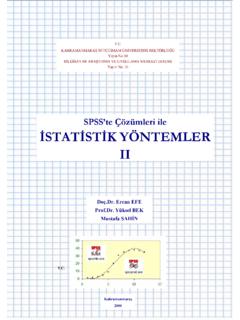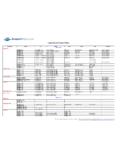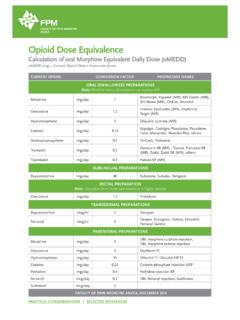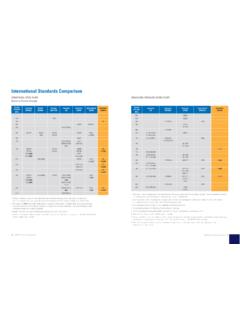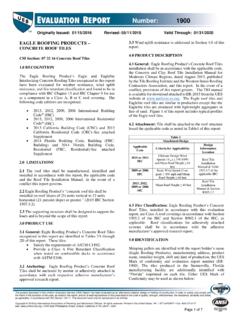Transcription of Displaying Data from Multiple Tables
1 Displaying data fromMultiple TablesChapter 41 ObjectivesAfter completing this lesson, you should be able to do the following: Write SELECT statements to accessdata from more than one table usingequality and nonequality joins View data that generally does not meet ajoin condition by using outer joins Join a table to itselfLesson AimThis lesson covers how to obtain data from more than one table , using the different methods product A Cartesian product is formed when: A join condition is omitted A join condition is invalid All rows in the first table are joined to all rows in the second tableTo avoid a Cartesian product , always include a valid join condition in aWHERE a Cartesian ProductSELECT ename, dnameFROM emp, dept;ENAME DNAME BLAKE ACCOUNTING SMITH ACCOUNTING ALLEN ACCOUNTING 56 Rows Selected4 What Is a Join?
2 Use a join to query data from more than one SyntaxWrite the join condition in the WHERE , table2. column2 FROM table1, table2 WHERE tablel. columnl = table2. column2;ANSI SyntaxWrite the join condition in the ON , table2. column2 FROM table1 INNER JOIN table2 ONtablel. columnl = table2. column2;Prefix the column name with the table name when the same column name appears in more than one JoinsWhen data from more than one table in the database is required, a join condition is used. Rows in one table can be joined to rows in another table according to common values existing in corresponding columns, that is, usually primary and foreign key display data from two or more related Tables , write a simple join condition in the WHERE clause, in the denotes the table and column from which data is retrievedTable1.
3 Column1 = table2. column2 is the condition that joins (or relates) the Tables together. 5 Types of Joins Equijoin Non-equijoin Outer join Self join6 Types of JoinsThere are two main types of join conditions: Equijoins Non-equijoinsAdditional join methods include the following Outerjoins Selfjoins Set OperatorsNote: Set operators are not covered in this course . They are covered in another SQL Is an Equijoin?EquijoinsTo determine the name of an employee s department, you compare the value in the DEPTNO column in the EMP table with the DEPTNO values in the DEPT table .
4 The relationship between the EMP and DEPT table is an equijoin - that is, values in the DEPTNO column on both Tables must be equal. Frequently, this type of join involves primary and foreign key : Equijoins are also called simple joins or data from Multiple TablesSELECT , , emp e, dept d WHERE = ; data from Multiple TablesSometimes you need to use data from more than one table . In the slide example, the report displays data from two separate Tables . EMPNO exists in the EMP table DEPTNO exists in both the EMP and DEPT the Tables . LOC exists in the DEPT prod ce the report.
5 You need to link EMP and DEPT Tables and access data from both of SyntaxSELECT , , emp e inner join dept d on = ;9 Retrieving Records with EquijoinsSELECT , , , , EMP, DEPTWHERE = ENAME DEPTNO DEPTNO LOC 7698 BLAKE 30 30 CHICAGO 7369 SMITH 20 20 DALLAS 7499 ALLEN 30 30 CHICAGO 14 rows Records with Equijoinsin the slide examaple. The SELECT clause specifies the column names to retrieve:-employee name, employee number, and department number, which are columns in the emp table -department number, department name, and location, which are columns in the DEPT FROM clause specifies the two Tables that the database must access:EMP tableDEPT tableThe WHERE clause specifies how the Tables are to be joined.
6 Ambiguous Column NamesUse table prefixes to qualify column names that are in Multiple performance by using table columns that have identical names but reside in different Tables by using column Ambiguous Column NamesYou need to gualify the names of the columns in the WHERE clause ""itli the table names to avoid ambiguity without the table prefixes. the DEPTNO column could be from either the DEPT table or the EMP table . It is necessary to add the table prefix to execute your there are no common column names between the two Tables , there is no need to qualify the columns.
7 Howevwr, you will gain improved performance by using the table prefix because you tell the Oracle Server exactly where to find the , , , , FROM emp, deptWHERE = ;EMPNO ENAME DEPTNO DEPTNO LOC 7698 BLAKE 30 30 CHICAGO 7369 SMITH 20 20 DALLAS 14 rows table AliasesThe following two scripts are equivalent. In the second one table aliases are , , emp e , dept d WHERE = ; ENAME DEPTNO DNAME BLAKE 30 SALES SMITH 20 RESEARCH 14 rows Search Conditions Using the AND Operator Additional Search ConditionsIn addition to the join, you may have criteria for your WHERE clause.
8 For example, to display King's employee number, name, department number, and departments localion, you need an additional condition in the WHERE , , , , EMP, DEPTWHERE = INITCAP(ename) = 'King' ; EMPNO ENAME DEPTNO DEPTNO LOC 7839 KING 10 10 NEW YORK 14 ANSI SsyntaxORACLE da Inner Join i yapanFROM emp e, dept d WHERE = emp e INNER JOIN dept d inner Join ko ulu yaz ld ktan sonra iki tablo aras nda ba lant y kuranON = ulu yaz l r. E er, ayr ca sat rlardan yeni s zme yap lacaksa WHERE ile istenen ko ul konulabilir:WHERE INITCAP(ename) = 'King' ;Bi imindeki ko ul yaz labilir.
9 RnekSELECT , , , , FROM emp e INNER JOIN dept d ON = INITCAP(ename) = 'King' ; EMPNO ENAME DEPTNO DEPTNO LOC 7839 KING 10 10 NEW YORK 15 Non-EquijoinsThe relationship between the EMP table and the SALGRADE table is a non-equijoin, meaning that no column in the EMP table corresponds directly to a column in the SALGRADE table . The relationship between the two Tables is that the SAL column in the EMP table is between the LOSAL and HISAL column of the SALGRADE table . The relationship is obtained using an operator other than equal (=).
10 SELECT *FROM emp ;EMPNO ENAME JOB MGR HIREDATE SAL COMM DEPTNO 7698 BLAKE MANAGER 7839 01/05/1981 2850 30 14 rows *FROM salgrade ;GRADE LOSAL HISAL 1 700 1200 2 1201 1400 3 1401 2000 4 2001 3000 5 3001 9999 5 rows records where Salary in the EMP table is between low salary and high salary in the SALGRADE , , EMP e, SALGRADE sWHERE AND ;ENAME SAL GRADE SMITH 800 1 JAMES 950 1 14 rows SyntaxSELECT , , EMP e INNER JOIN SALGRADE sON AND ;ENAME SAL GRADE SMITH 800 1 JAMES 950 1 14 rows More Than Two TablesSELECT , , , emp e, dept d, salgrade sWHERE = BETWEEN AND hisal;ENAME DEPTNO DNAME GRADE KING 10 ACCOUNTING 5 CLARK 10 ACCOUNTING 4 MILLER 10 ACCOUNTING 2 FORD 20 RESEARCH 4 SCOTT 20 RESEARCH 4 JONES 20 RESEARCH 4 ADAMS 20 RESEARCH 1 SMITH 20 RESEARCH 1 BLAKE 30 SALES 4 ALLEN 30 SALES 3 TURNER 30 SALES 3 MARTIN 30 SALES 2 WARD 30 SALES 2 JAMES 30 SALES 1 14 rows SyntaxSELECT , , , salgrade s, emp e INNER JOIN dept d ON = BETWEEN AND.



